System of play : Quiz + Ans [ P3] Playing out from the back
Manningham U12 2019
[9v9 Half Pitch with Offside]
System of Play : Quiz
[We have covered most of this to some degree or another as @ 28/2/19]
Section Three :
Playing out from the back; In Youth Football
-
Why cant the keeper or defenders just boot it out of the defencive third? Becuase a boot by-passes a group of players (defencive and midfield line) who need to play out to get better. Yes it may result in a mistake and yes in may result in a goal, the need to learn is more important. If the ball gets booted over the heads of players, these players miss a valuable learning opportunity.
Playing out from the back - 9-a-side ; Half pitch - specific to our system of pay
[ Note our way of playing out does not perfectly match how you would do it on a full pitch (11-a-side) and with a keeper who can over the top to wide players]
-
When the keeper is playing out, how low and wide in our system, should the CBs Be (9v9 on half pitch)? Not low or wide at all. Our CBs keep neutralk positions. That is 45 degrees off the GK and on the defencive line (equivalent to the edge of the box on a full size pitch).
-
If the CBs and 6s have space should the keeper ignore them or given then the ball? Yes - always.
-
If both CBs and 6s are tightly marked, who drops to receive in our system? The wide players [but only if the CBs or 6s cant get the ball - which is often in 9v9 on half a pitch]
-
If all our low players are tightly marked (2xCBs, 2x6s, 2vW) and all quite low,
-
What are the 'numbers' higher up the pitch? 2v2 [Ignoring the opposition keeper]
- So what should the keeper do? Play to the 2v2
- This an example of knowing when to break the ...Rules........
- What rule is being broken? The rule that we must playout from the GK
Playing out from the back
1. Draw our general starting postions?
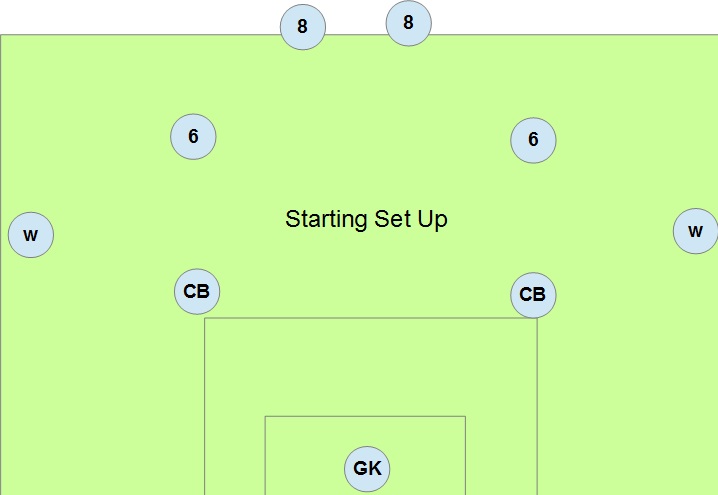
2. What are the main ways the defence might set up?
Scenario 1
Image Not Found.Scenario 2
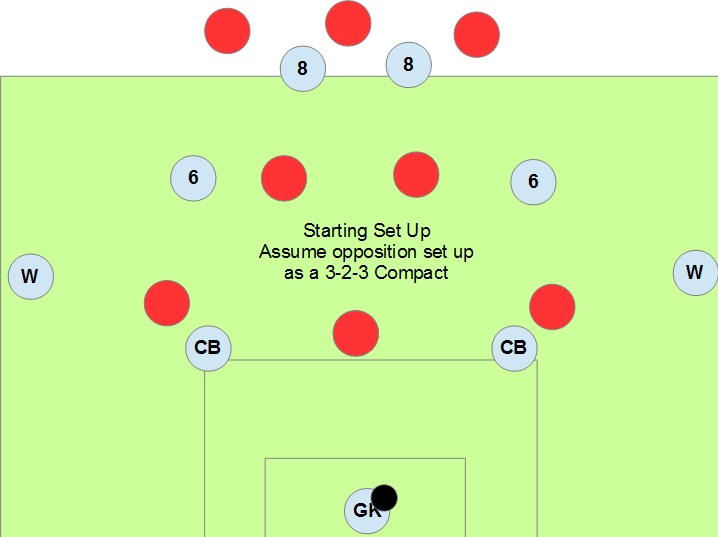
Scenario 3
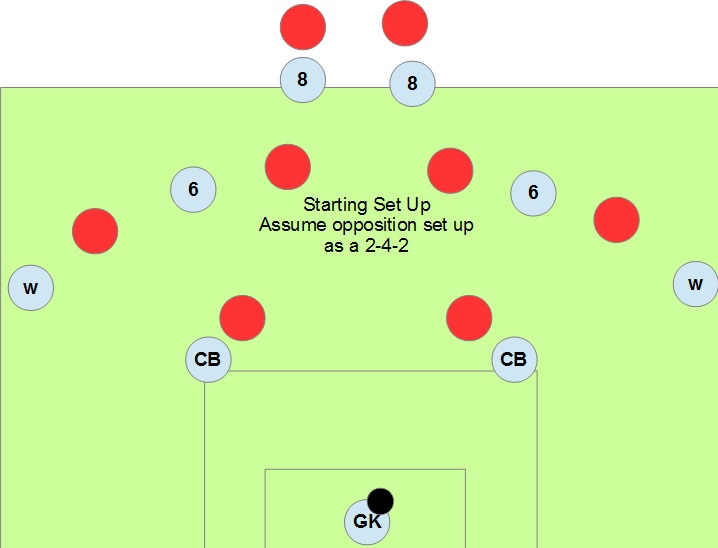
These are the 'pictures' the goal keeper might see (or even some other variation). Each has implications for how a team plays out. If we make the assumptions that the opposition will press the ball once the keeper plays it and that the opposition will defend the lines between the ball and the goal, what is the best option for the keeper in each scenario, and what will happen as the play unfolds?
2. Using scenario one - what is the best option foo the keeper?
THis is the picture. The CB has space to receive but he will get pressed.
Arrows depict player movements as the ball rolls to the CB. If he can open up then he can get out using the diamond set up around him. If he cant open up, he can bounce back to the keeper. If he can protect the ball and spin out he can still hit the wide player.
The movement of all players might end up something like this.
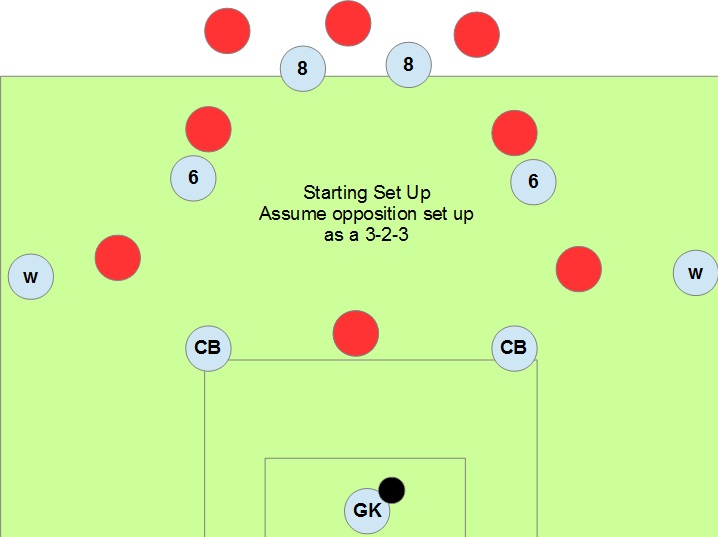
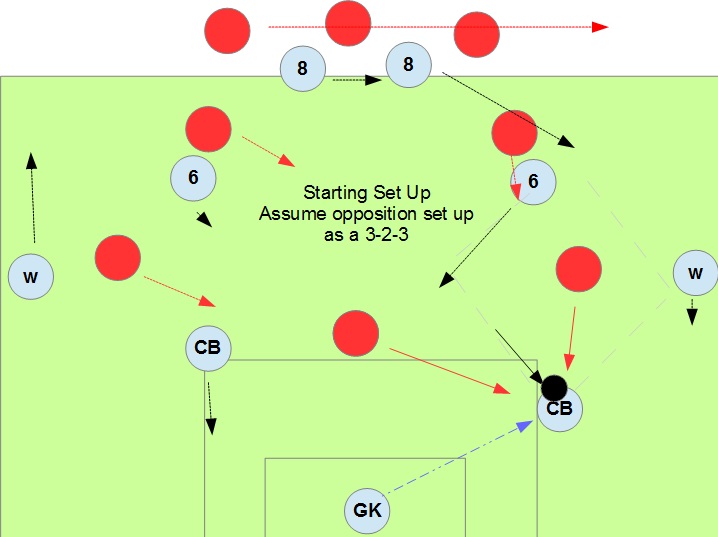
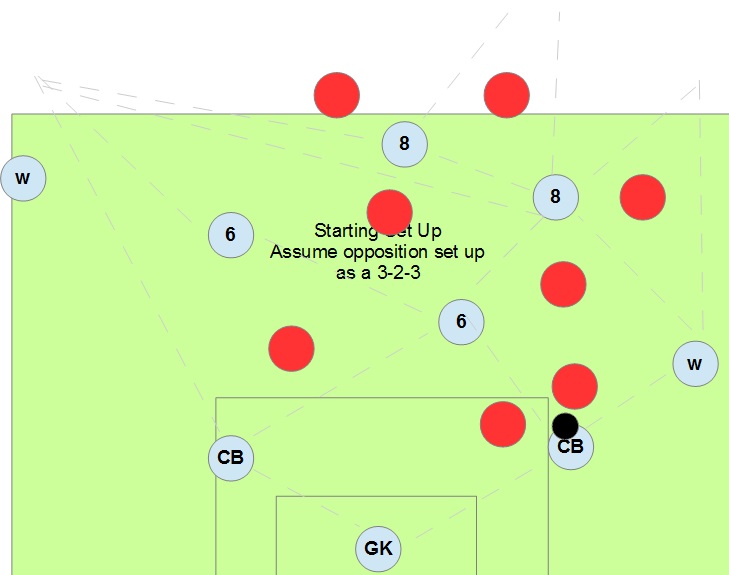
- In picture 1 , why can the CB receive the ball?
- In picture 2, Which player moved counter to the ball (and is the key to unlocking the press)?
- In picture 2, study all the movement. What are the Rondos (numbers) around the ball and away from the ball?
- In picture 3 what have the opposition done as a unit?
- In picture 3, what are the 2 key areas of attack?
- In picture 3, which arae is least defebnded?
- In picture 3, what should the big picture objective be?
3. Using scenario two - what is the best option for the keeper?

4. Using scenario three- what is the best option for the keeper?

Start again from here
2. What are the main ways the defence might set up?
- If a wide player drops low to get the ball off the keeper in the defencive third, there are a few main ways to set up a diamond around him.When playing out especially (but also sometimes elsewhere on the pitch)
-
Draw as many ways as you can think off and discuss the pros and cons?
- One method (I will call it the magic 6 rotation) includes counter movement, and magically makes one 6 appear unmarked in space? (Assuming all defenders move with their man and in the direction of the ball)
- If you have included this, then add it to the ones you came up with.
- Where are the key technical moments in this process?
- Where are the key unorthodox movement patterns (intelligent movement) in this?
- Do players need to be very clever and technical to make a rotation work or can any player do it?
-
- Why are square ball dangerous to do?
- Explain this using diagrams and real game examples
- Why are vertical passes usely not effective when playing out from the back (unless there has been a fast switch)? This is because........